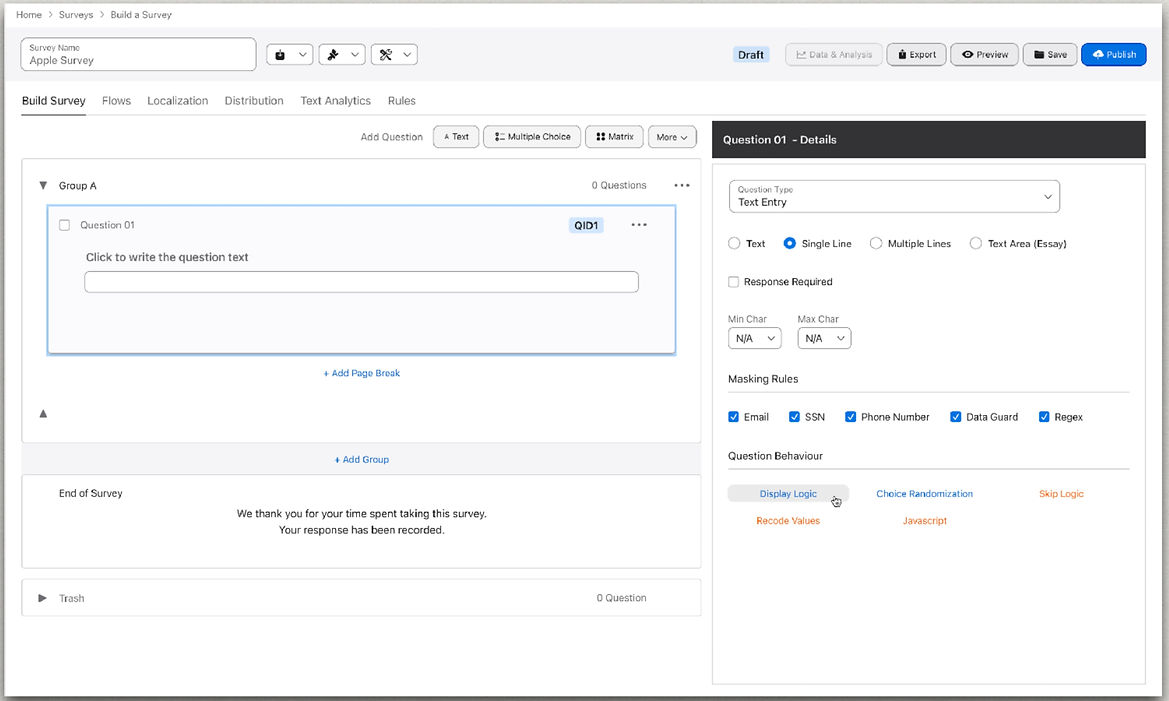
Survey Authoring
Mohan Vamsee Gunthati
Product Designer

Abstract
This case study focuses on Survey Authoring, that allows users to create, distribute, and analyze surveys. The aim of this study is to assess the eectiveness of recent updates aimed at enhancing user experience and engagement within the application. This application mainly intended to use for internal audience individuals, businesses, and management leaders worldwide. The application provides a user-friendly interface for creating and managing surveys, as well as powerful analytics tools for extracting insights from survey data. In response to user feedback and evolving industry standards, this product development team implemented several updates to improve user experience and engagement.

Problem Statement
Existing Survey Building Application faces critical user experience challenges that hinder its full potential. While it boasts powerful survey-building capabilities, it falls short in several key areas, leading to user frustration and suboptimal survey creation experiences. Above all it is highly paid 3rd party tool which client planned to build an own Survey Tool to end subscription.
Limited Customization Options:
Users report a lack of flexibility in customizing survey themes, fonts, and colors, limiting their ability to align surveys with their brand identity and objectives.
Complex Navigation:
The current navigation structure lacks intuitiveness, causing users to struggle when locating specific features, resulting in a suboptimal workflow.
Accessibility Concerns:
The application does not meet certain accessibility standards, making it difficult for users with specific accessibility needs to navigate and utilize the platform effectively.
Inefficient Question Formatting:
Users face challenges in formatting questions, particularly in scenarios involving complex skip logic and branching, leading to a frustrating survey creation process.
Lack of Real-Time Collaboration:
The absence of real-time collaboration features hinders teams from working on surveys together, resulting in inefficient and disjointed collaboration efforts.
Reporting Tools Limitations:
The current reporting tools are not as robust as users require, making it challenging to derive meaningful insights from survey data.
Objectives
-
Enhance Customization Capabilities: Provide users with various customization options to create surveys that align with their brand identity and objectives.
-
Optimize Navigation and UI/UX: Improve the application's navigation and overall user interface to enhance the user experience and streamline survey creation workflows.
-
Prioritize Accessibility Features: Implement accessibility enhancements to ensure the application is usable by individuals with specific accessibility needs.
-
Enhance Customization Capabilities: Provide users with various customization options to create surveys that align with their brand identity and objectives.
-
Optimize Navigation and UI/UX: Improve the application's navigation and overall user interface to enhance the user experience and streamline survey creation workflows.
-
Prioritize Accessibility Features: Implement accessibility enhancements to ensure the application is usable by individuals with specific accessibility needs.

Success Metrics

User Satisfaction
Aim for a 40% increase in user satisfaction scores following the implementation of UX improvements.
Reduced Drop-off Rates
Target a 30% reduction in drop-o rates during survey creation sessions.
Increased User Engagement
Strive for a 50% increase in average session duration
Accessibility Compliance
Ensure the application meets key accessibility standards, as outlined in WCAG 2.0 guidelines as per the client standards.
Added Large Language Model (LLM)
As part of building new product, LLM was introduced to enhance user engagement and better experience while creating a survey.
Survey Builder Screen

Survey Preview Screen

Survey Landing Dashboard Screen


Post-Update User Experience Assessment
Improved Usability
Usability scores saw a notable increase to an average of 4.4 out of 5, indicating a substantial improvement in overall usability. Participants praised the simplied navigation and intuitive layout, which facilitated a smoother survey creation process.
Enhanced Customization Options
Users reported a signicant improvement in customization capabilities, particularly in selecting themes, fonts, and color schemes. The introduction of advanced skip logic and branching options empowered users to create more dynamic and tailored surveys.
User Satisfaction
Following the updates, user satisfaction increased signicantly to 86%. Participants praised the new customization options and improved collaboration features.
Feature Adoption
New features, such as real-time collaboration and advanced reporting tools, saw high adoption rates.
User Engagement
Average session duration increased by 18%, indicating higher engagement levels.